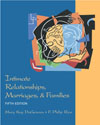 |  Intimate Relationships, Marriages, and Families, 5/e Mary K. DeGenova
Philip F. Rice
Companionship in and Outside the Family
Chapter OverviewLove and companionship are primary motives for marriage in our impersonal society.
Companionship in marriage makes a couple's relationship more satisfying--although,
for a variety of reasons, it does not always develop. There are advantages and
disadvantages in the three different styles of companionship--joint, parallel,
and segregated. People differ in their need for closeness, which is not the
same as possessiveness, as well as in their need for time alone. Some people
experience loneliness, which can occur even when not alone, when one does not
have the kind of social relations desired. Loneliness results from situations
as well as from personality attributes. Individuals and families need balanced
recreation, including physical and nonphysical activities. Interpersonal competence
in general social relationships can be a predictor of interpersonal competence
in marriage. Vacations can be positive or destructive for family members; television
watching and computer usage in excess can be destructive. Having friends is
important to psychological and social well-being, but it can be difficult to
make friends in cities. Women tend to develop friendships based on emotional
sharing, and men base their friendships on sharing of interests and activities.
Spousal jealousy can occur in opposite-sex relationships. |
|



 2002 McGraw-Hill Higher Education
2002 McGraw-Hill Higher Education